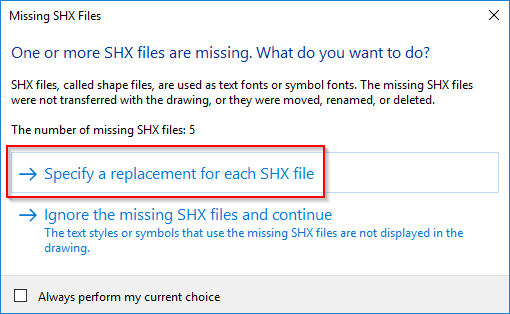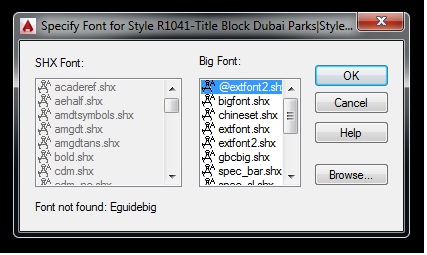A very common issue with AutoCAD is the presence of the dialog below. If you receive this dialog, it means you are missing a shape file that is referenced in the drawing. Shape files contain shapes that can be used by themselves, sort of like blocks. Most likely though, they are part of a complex linetype definition.
Specify
AutoLISP: Purge Missing SHX files Posted on June 3, 2013 by AutoCAD Tips If you have drawings that are constantly missing SHX (shape) files, the routine posted below is now your friend. Suppose you make a shape file named “Custom.shx” and you define a shape inside of this file named “Box” and then finally, you create a complex linetype that references this shape named “Box”. You can be assured that the shape named “Box” inside the file “Custom.shx” will be used in your linetype. Every time you open a drawing in AutoCAD that references shape files that are not on your system, a dialog box is displayed and you are prompted to locate missing shape (SHX) files. This problem can occur when you receive drawings from other users, and the associated shape files are not provided with the drawing. The best way to resolve this problem is to obtain the missing shape files.
If you choose “Specify a replacement for each SHX file”, then you will get the file selection dialog shown below so that you can specify the location of the SHX file. If you do not have it, then perhaps you received this drawing from someone else? If so, ask them for the shape file, and then ask them to use eTransmit next time they send you a drawing so this won’t happen. eTransmit packages the drawing file together with all dependent files (such as shape files, images, and External Drawing references)
What if this is an internal drawing that you have been working on for a while? In that case, maybe the shape file was moved from it’s original location, or maybe your support file search path was changed, and it no longer includes the directory where the shape file lives. In any case, AutoCAD cannot find the shape file. Search your machine and/or your network for this file. The actual shape file name is located in the file name portion of the “Select Shape File” dialog.
Ignore
If you choose “Ignore the missing SHX files and continue”, then you can continue working in the drawing. But note that you may be missing some data, and it’s almost certainly components of complex linetypes.
If you want to remove the SHX file references forever, you will need to purge them from the drawing. But first you’ll have to purge whatever is referencing them, again most likely one or more linetypes. Purge all linetypes and then see if the shape file can be purged. If not, keep digging. Set all layers to use the Continuous linetype, and make sure all entities are set to Bylayer linetype. Purge again. This should free up the shape file for purging if it was referenced in a linetype.
If you do not have access to the required SHX file, it probably will not do much good to ask someone for it. Many times we see people in various CAD forums asking for a certain shape file name. The chances of this working are very slim. Let’s say that you are missing a shape file named “pro-lm.shx”, and you do happen to find someone who has the same file, it’s doubtful that it is the exact same file. Anyone can create a shape file and give it this name. Shape files contain shapes referenced by number. If your drawing uses shape #114 defined in “pro-lm.shx”, and you replace it with a file named “pro-lm.shx” that doesn’t include shape #114, you are going to be in the same boat as before. Even worse, the replacement file may contain a shape #114 that isn’t the same as the original.
If that didn’t do it, run QSELECT and see if any SHAPE entities are present in the drawing. If so, you can select and delete them even though they are not visible.
How To Create Shx File In Autocad Files
Lastly, try this lisp file. This will search for three things.
/Creating-a-linetype-in-AutoCAD/Linetype-2.png.aspx)
- Complex linetypes that reference a shape file.
- All loaded shape files.
- Any inserted shapes.
Still stuck? If you are still stuck after all this, head over to http://www.manusoft.com and take a look at SuperPurge. It has a “hard purge” feature that will purge anything (read the warnings…)
As always, whether you are doing this manually, with the attached lisp, or with a product like SuperPurge, work on a backup of your drawing until you are sure what you are doing. Good luck.
Feel free to let us know if none of these suggestions work. You can even send us a drawing if you wish. I have only tested these suggestions on a limited number of drawings, and I’m sure there are some cases out there that we have not covered.

Related Posts
SHXConvert 5.0 Features
How To Open Shx File

Features:
• Input all AutoCAD DXF/DWG versions to AutoCAD 2019.
• Translate AutoCAD-86 shapes 1.0, 1.1, Bigfont, Extended Bigfont, and Unifont 1.0 formats.
• Compile AutoCAD Shape/Font files outside of AutoCAD
• Decompile existing shape/font files.
• Fully commented SHP source (as part of SHX decompile) lets you easily undestand those cryptic codes!
• Convert individual .SHX files to equivalent DXF format files.
• Replace all references to .SHX SHAPES and/or TEXT fonts in a DXF file with BLOCK geometry. (The relevant .SHX files must of course be present for such translation to occur).
• In short the software performs a global Shape to Block conversion. Useful where the end-application does not have native support for .SHX shapes or fonts (e.g. Revit)
• Optionally preserve Arcs in shapes as actual arcs, i.e. not converted to a series of small lines. This gives a more accurate result. It is also suited to CAM and CNC cutting machines.
• Handle Sub-shapes.
• Explode SHP/SHX to a simple vectors (.DAT file.)
• Explode all text inside a DXF file into component geometry, i.e. lines and arcs.
• Allow you to send out DXF/DWG files to clients without the need to send the relevant .SHX files.
New in version 4.0
• Read support for all AutoCAD DXF and DWG drawings up to AutoCAD 2019.
• Explode output text option (rather than keep the geometry within BLOCK entities)
• Support for MTEXT and TABLE entities.
